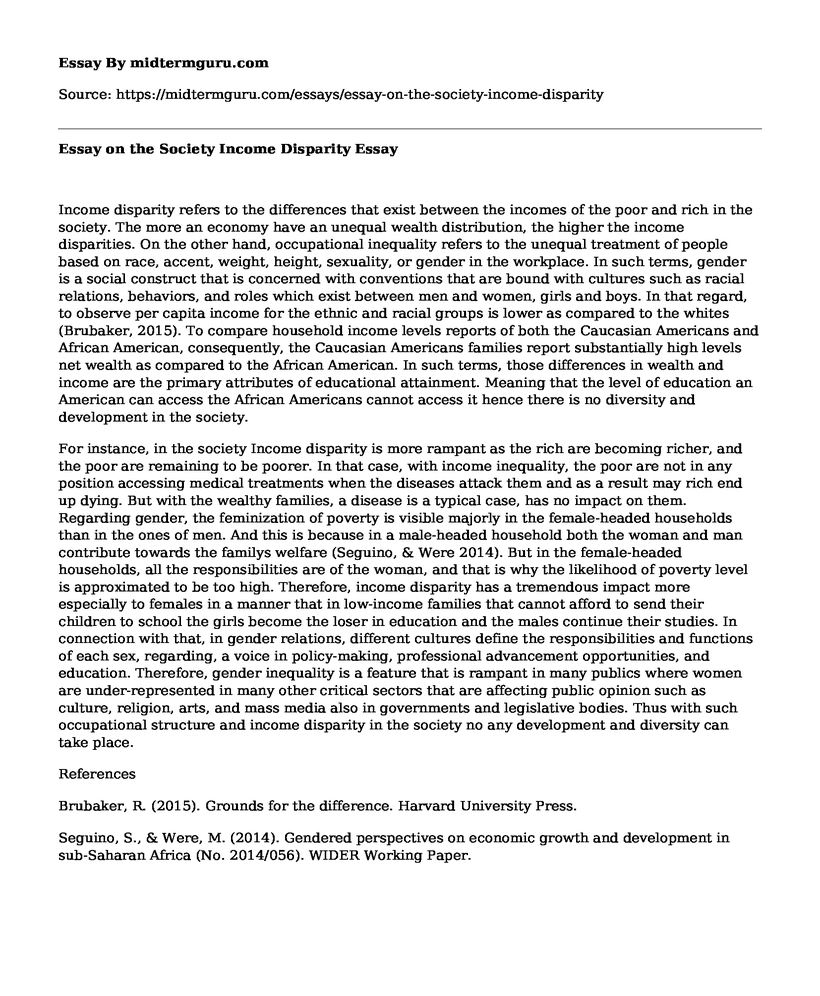Income disparity refers to the differences that exist between the incomes of the poor and rich in the society. The more an economy have an unequal wealth distribution, the higher the income disparities. On the other hand, occupational inequality refers to the unequal treatment of people based on race, accent, weight, height, sexuality, or gender in the workplace. In such terms, gender is a social construct that is concerned with conventions that are bound with cultures such as racial relations, behaviors, and roles which exist between men and women, girls and boys. In that regard, to observe per capita income for the ethnic and racial groups is lower as compared to the whites (Brubaker, 2015). To compare household income levels reports of both the Caucasian Americans and African American, consequently, the Caucasian Americans families report substantially high levels net wealth as compared to the African American. In such terms, those differences in wealth and income are the primary attributes of educational attainment. Meaning that the level of education an American can access the African Americans cannot access it hence there is no diversity and development in the society.
For instance, in the society Income disparity is more rampant as the rich are becoming richer, and the poor are remaining to be poorer. In that case, with income inequality, the poor are not in any position accessing medical treatments when the diseases attack them and as a result may rich end up dying. But with the wealthy families, a disease is a typical case, has no impact on them. Regarding gender, the feminization of poverty is visible majorly in the female-headed households than in the ones of men. And this is because in a male-headed household both the woman and man contribute towards the familys welfare (Seguino, & Were 2014). But in the female-headed households, all the responsibilities are of the woman, and that is why the likelihood of poverty level is approximated to be too high. Therefore, income disparity has a tremendous impact more especially to females in a manner that in low-income families that cannot afford to send their children to school the girls become the loser in education and the males continue their studies. In connection with that, in gender relations, different cultures define the responsibilities and functions of each sex, regarding, a voice in policy-making, professional advancement opportunities, and education. Therefore, gender inequality is a feature that is rampant in many publics where women are under-represented in many other critical sectors that are affecting public opinion such as culture, religion, arts, and mass media also in governments and legislative bodies. Thus with such occupational structure and income disparity in the society no any development and diversity can take place.
References
Brubaker, R. (2015). Grounds for the difference. Harvard University Press.
Seguino, S., & Were, M. (2014). Gendered perspectives on economic growth and development in sub-Saharan Africa (No. 2014/056). WIDER Working Paper.
Cite this page
Essay on the Society Income Disparity. (2021, Jun 25). Retrieved from https://midtermguru.com/essays/essay-on-the-society-income-disparity
If you are the original author of this essay and no longer wish to have it published on the midtermguru.com website, please click below to request its removal:
- Globalization, Civil Society and Global Poverty - Paper Example
- Money and the Prices in the Long-Run and Open Economics - Paper Example
- Research Paper on Supply And Demand for Global Air Transportation
- U.S. Immigration: Assimilation, Culture, and Economics - Essay Sample
- Microsoft's Employee Benefits Package: Achieving the Goal - Essay Sample
- Slotting Fee: Ethical or Unethical? - Essay Sample
- Verizon Wireless: Examining Fiscal Policy in a Competitive Market - Essay Sample







